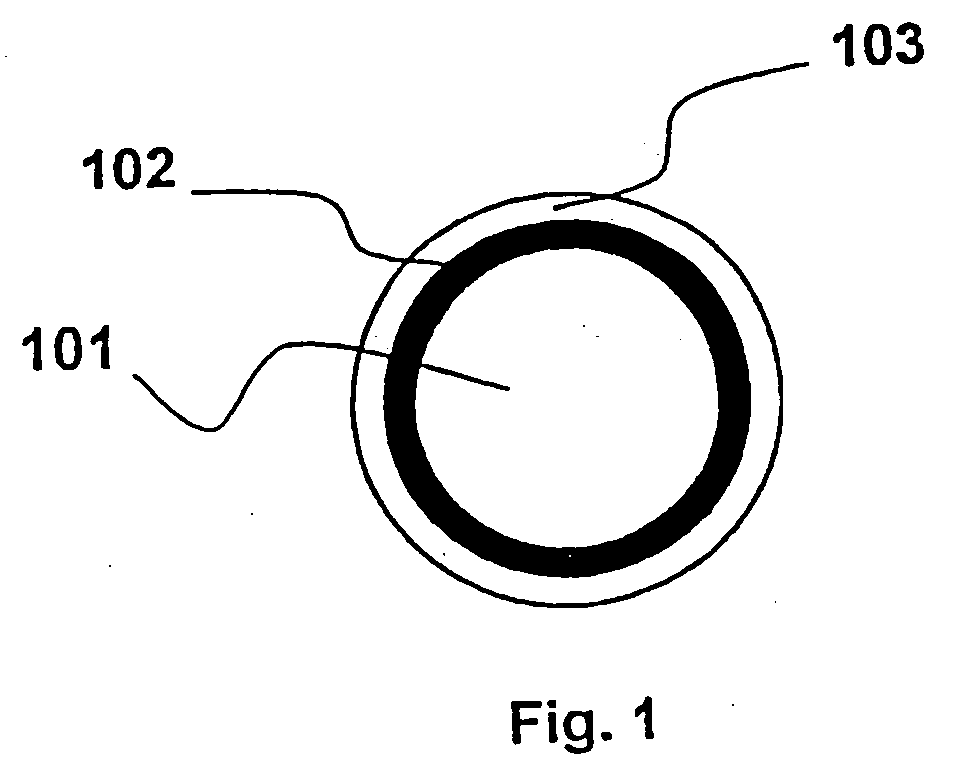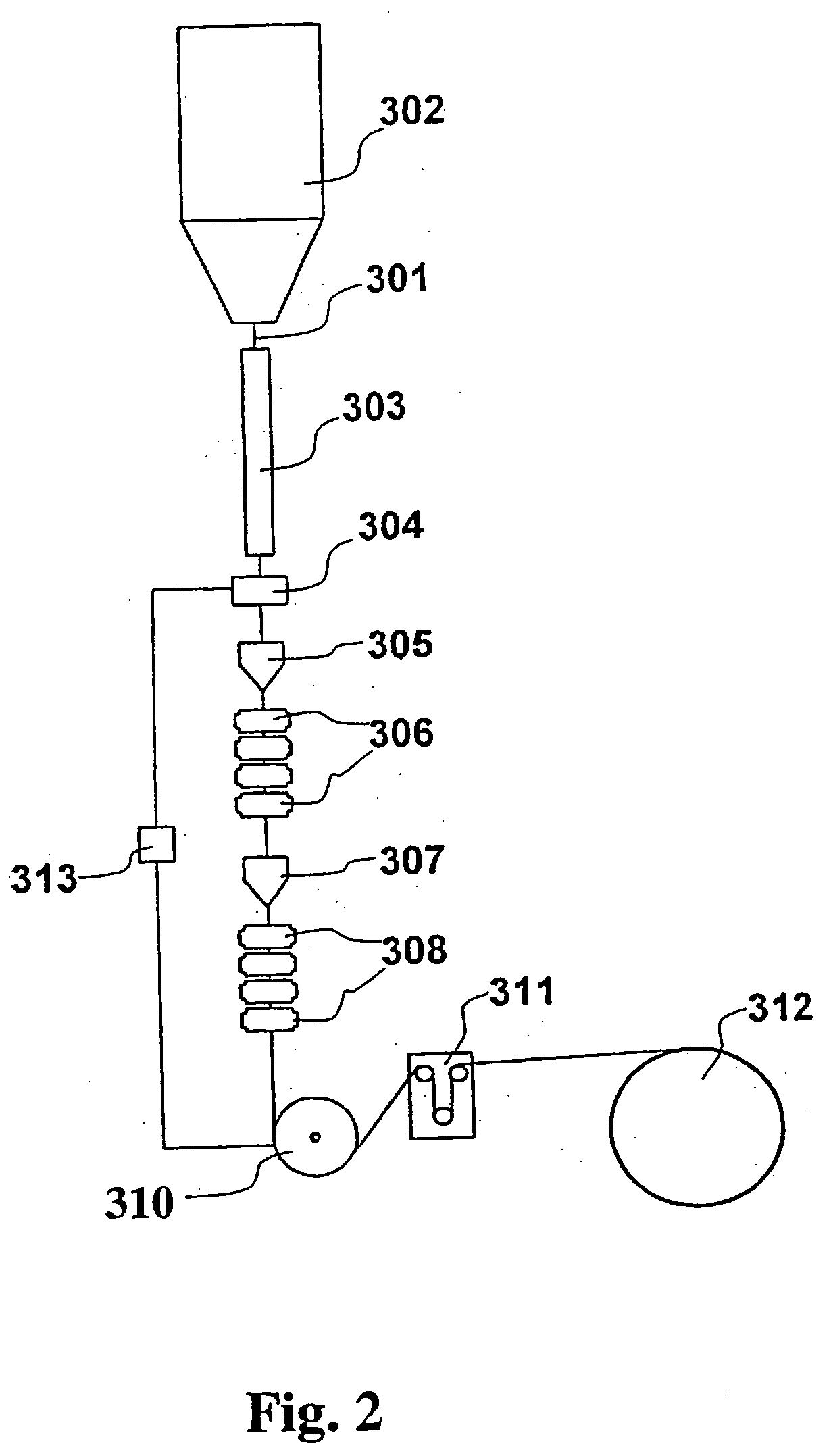Optical fiber with epoxidized polyolefin based coating
a technology of epoxidized polyolefin and optical fiber, applied in the field of optical fiber, can solve the problems of unwanted phenomena, contamination of other materials, environmental and health hazards of workers, etc., and achieve the effects of low modulus of elasticity value, low cost, and acceptable viscosity
- Summary
- Abstract
- Description
- Claims
- Application Information
AI Technical Summary
Benefits of technology
Problems solved by technology
Method used
Image
Examples
examples 1-5
Preparation of Compositions for Primary Coating
[0112] Compositions for the primary coating according to the invention were prepared: the amounts of the components (parts by weight except where otherwise mentioned) are given in Table 1.
TABLE 1COMPOSITIONSCOMPONENTS1 (*)2 (*)345Poly Bd ® 60576————Kraton ® Liquid—80505050L-207Kraton ® Liquid——50—30L-1203Kraton ® Liquid———5020L-2203Rapicure ® HBVE24————Rapicure ® CHVE—20———UVI ® 6974 1 1 1 1 1
(*): comparative
Poly Bd ® 605: epoxidized polybutadiene sold by Elf Atochem;
Kraton Liquid ™ EKP-207: linear oligomer containing a poly(ethylene / butylene) aliphatic chain, a hydroxyl group at one end and epoxide groups at the other end, sold by Kraton Polymer;
Kraton Liquid ™ L-1203: hydroxy-terminated hydrogenated polydiene oligomer sold by Kraton Polymer;
Kraton Liquid ™ L-2203: dihydroxy-terminated hydrogenated polydiene oligomer sold by Kraton Polymer;
Rapicure ® HBVE: 4-hydroxybutyl vinyl ether sold by ISP;
Rapicure ® CHVE: cyclohexane dim...
example 6
Mechanical and Chemical-Physical Analyses
[0114] The compositions of Examples 1-5 were subjected to the following mechanical and chemical-physical analyses.
[0115] The viscosity of the non-crosslinked compositions obtained according to Examples 1-5 was measured, at 30° C. and at 80° C., using a viscometer of Brookfield type, model DV-III, equipped with a configuration 29. The results obtained are given in Table 2.
Modulus of Elasticity Values
[0116] Films were obtained from the abovementioned compositions by working as follows. A film 70 μm in thickness and 120 mm in width was spread onto a glass plate using the “Bird” filmograph at a speed of 2 m per minute; the crosslinking of the film was carried out using a Fusion UV curing System device, model F600 and lamp with spectrum H, applying a UV dose of 1.25 J / cm2. At the end of the crosslinking, the films were removed from the glass plate.
[0117] The film obtained from the composition of Example 2 was not subjected to furt...
examples 7-11
Preparation of Compositions for Primary Coating with Adhesion Promoter
[0134] Compositions for primary coating with adhesion promoter according to the invention were prepared: the amounts of the components (parts by weight except where otherwise mentioned) are given in Table 3.
TABLE 3COMPOSITIONSCOMPONENTS7891011(a) Kraton ® Liquid5050505050L-207(b) Kraton ® Liquid5050505050L-1203BYK ® 3610.50.50.50.50.5Silquest ® A-187—1.0———Silquest ® A-186——1.0——Dynasylan ® MTMO———1.0—Si ® 2661.0UVI ® 69740.50.50.50.50.5
Kraton Liquid ™ EKP-207: linear oligomer containing a poly(ethylene / butylene) aliphatic chain, a hydroxyl group at one end and epoxide groups at the other end, sold by Kraton Polymer;
Kraton Liquid ™ L-1203: hydroxy-terminated hydrogenated polydiene oligomer sold by Kraton Polymer;
BYK ® 361: polyacrylate copolymer sold by BYK-Chemie [the amount given is relative to 100 parts of the components (a) + (b)];
Silquest ® A-I87: gamma-glycidoxypropyltrimethoxysilane sold by OSi Specia...
PUM
| Property | Measurement | Unit |
|---|---|---|
| average molecular weight | aaaaa | aaaaa |
| average molecular weight | aaaaa | aaaaa |
| viscosity | aaaaa | aaaaa |
Abstract
Description
Claims
Application Information
 Login to View More
Login to View More - R&D
- Intellectual Property
- Life Sciences
- Materials
- Tech Scout
- Unparalleled Data Quality
- Higher Quality Content
- 60% Fewer Hallucinations
Browse by: Latest US Patents, China's latest patents, Technical Efficacy Thesaurus, Application Domain, Technology Topic, Popular Technical Reports.
© 2025 PatSnap. All rights reserved.Legal|Privacy policy|Modern Slavery Act Transparency Statement|Sitemap|About US| Contact US: help@patsnap.com



